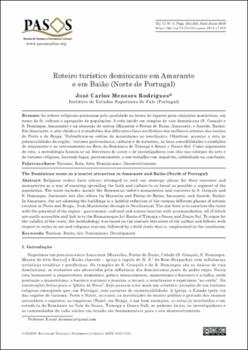Roteiro turístico dominicano em Amarante e em Baião (Norte de Portugal)
Fecha
2019Resumen
As ordens religiosas primaram pela qualidade na busca de lugares para conjuntos monásticos, em
nome da fé, cultura e agregação de populações. A rota incide em templos de raiz dominicana (S. Gonçalo e
S. Domingos, Amarante) e na absorção de outros (Mancelos e Freixo de Baixo, Amarante, e Ancede, Baião).
Em Amarante, a arte obedece à tratadística das diferentes fases estilísticas dos melhores artistas das escolas
do Porto e de Braga. Vislumbram‑se
estilos do maneirismo ao neoclássico. Objetivos: associar a rota às
potencialidades da região ‑
turismo gastronómico, cultural e de natureza, às boas acessibilidades e condições
de alojamento e ao entrosamento na Rota do Românico do Tâmega e Sousa e Douro Sul. Como argumento
de rota, a metodologia baseou‑se
na literatura do autor e de investigadores com elos nas estirpes da arte e
do turismo religioso, havendo lugar, posteriormente, a um trabalho com inquérito, sublinhado na conclusão. Religious orders have always attemped to seek out strategic places for their convents and
monasteries as a way of ensuring spreading the faith and culture to as broad as possible a segment of the
population. The route includes mainly the Dominican order’s monasteries and convents in S. Gonçalo and
S. Domingos, Amarante but also others (in Mancelos and Freixo de Baixo, Amarante, and Ancede, Baião).
In Amarante, the art adorning the buildings is a faithful reflection of the various different phases of artistic
creation in Porto and Braga., from Mannersim through to Neoclassical. The aim here is to associate the route
with the potential of the region ‑
gastronomic, cultural and nature tourism with accommodation, all of which
are easily accessible and link in to the Romanesque Art Route of Tâmega e Sousa and Douro Sul. To argue for
the validity of the route, the methodology was based on the reseach literature of the author and fellows with
respect to styles in art and religious tourism, followed by a field study that is, emphasized in the conclusion.





